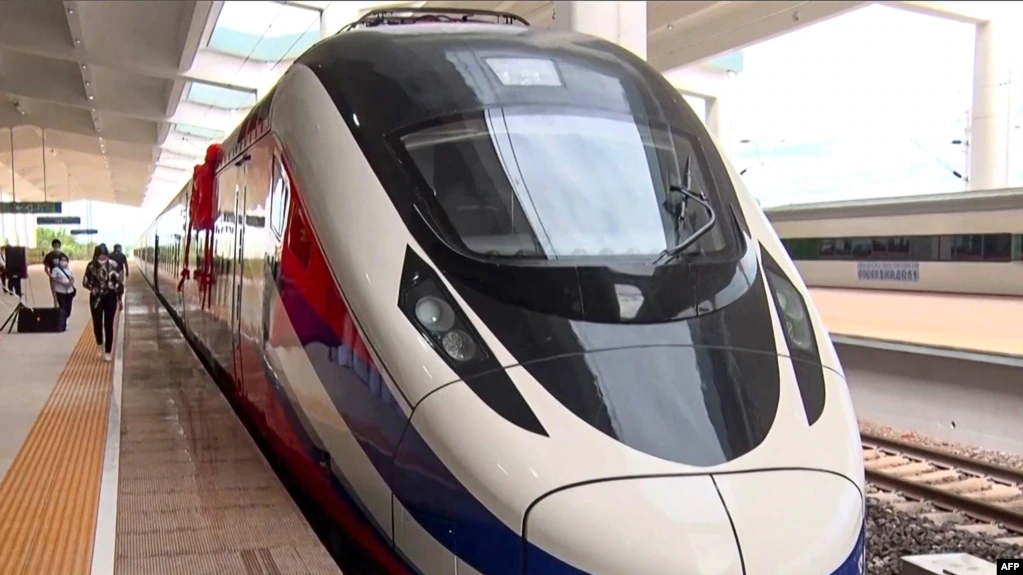Laos, deeply indebted to China for large-scale infrastructure projects, is at high risk of defaulting on its obligations, according to experts, a situation exacerbated by the economic stress felt worldwide due to the coronavirus and the war in Ukraine.
The international rating agency Moody’s downgraded Laos’ credit rating to Caa3 on June 14, citing “a very high debt burden and insufficient coverage of external debt maturities by (foreign exchange) reserves.” The agency warned that Laos’ default risk will remain high.
According to a World Bank report published in April, preliminary estimates indicated that Laos’ total public and publicly guaranteed debt reached 88% of gross domestic product in 2021. The debt is valued at $14.5 billion, about half of which is owed to China on loans to fund projects including the China-Laos railway.
Greg Raymond, a Southeast Asia expert and lecturer at the Australian National University, told VOA Mandarin that the crisis facing Vientiane has layered origins.
“The near-term reasons are the rise in oil prices due to war in Ukraine, and U.S. interest rate rises causing a fall in the value of the Lao currency,” he said.
“But deeper-level reasons would include the country’s decisions to go deeply into debt to fund large-scale infrastructure projects,” Raymond added. China continued to be the largest foreign investor in Laos last year, undertaking 813 projects worth more than $16 billion, according to Chinese state media Xinhua, citing Lao officials.
VOA Mandarin contacted the Chinese Embassy in Washington for comment on the loans to Laos and was referred to the Foreign Ministry in Beijing and the Lao Embassy. Inquiries placed at both offices were not answered.
The so-called “debt trap” incurred by accepting infrastructure financing from Beijing has also impacted Sri Lanka and other countries.
Beijing has poured more than $800 billion into its infrastructure-building “Belt and Road” initiative since 2013. The initiative is an essential tool in China’s quest to sell more goods and obtain contracts for its construction companies — in addition to challenging what it refers to as “American hegemony.”
But China has been accused by the U.S. and others of pursuing “debt-trap diplomacy” meant to make economically weak countries dependent on China for support. Chinese diplomats deny the accusations.
On Thursday, the Group of Seven nations pledged to raise a $600 billion fund from public and private sources to finance infrastructure projects in developing countries. The aim is to counter China’s efforts in the same sector.
AidData Lab at the College of William & Mary tracks debt for China’s Belt and Road projects. According the lab’s statistics, the total value of Laos’ public debt to China is about $12.2 billion, substantially higher than the World Bank calculation.
AidData Lab explains that it uses different sources and methodologies from the World Bank. But either of the multibillion-dollar estimates dwarfs the nation’s per capita GDP of about $2,600, making the Southeast Asian nation of 7 million one of the world’s poorest.
Bradley Parks, executive director of AidData, told VOA, “Over this 18-year period, the government of Laos contracted or guaranteed loans from official sector creditors in China worth $5.57 billion.” But that “is only the tip of the iceberg” he added, pointing to an additional $6.69 billion owed Beijing.
According to the World Bank, Laos must repay $1.3 billion of external debt every year until 2025, which almost equals the country’s federal exchange reserves and half of total domestic revenue. ]]
The World Bank forecasts that Laos’ economy will grow by 3.8% this year but warns this will not be enough to generate the fiscal revenue needed for the government to pay its foreign debt.
When addressing National Assembly members on June 20, Lao Minister of Finance Bounchom Ubonpaseuth said the annual debt-service payment had increased from $1.2 billion in 2018 to $1.4 billion this year.
The finance minister told lawmakers that the government would not let the country fall into default, saying that Laos would reform its tax system to increase revenue, and that there was potential to generate revenue from natural resources such as mining. The Lao government has restricted foreign exchange transactions by residents.
He added that the loans “were necessary for the development of our country in past years.”
For example, the China-Laos railway that connects Kunming in southwestern China to Vientiane, the capital of Laos, opened in December 2021 and cost $5.9 billion.
Laos hopes the railway will reduce transportation costs and boost exports and tourism.
The Laos-China Railway Company is 70% owned by three Chinese state-owned companies and 30% by the Lao government.
Laos incurred a $1.9 billion debt for the project, an additional obligation that may push Vientiane to seek some grace from Beijing on repayment.
China’s central bank, the People’s Bank of China, issued an emergency loan worth about $300 million to the central bank of Laos in 2021 to support its foreign exchange reserves, according to AidData Lab.
However, AidData’s Parks said, “Chinese state-owned policy banks are usually more willing to extend grace periods and repayment periods than reduce interest rates. In some cases, Chinese state-owned policy banks will even increase the interest rates that apply [to] the debts of a sovereign borrower in order [to] ensure that they recover enough total repayment over the lifetime of a loan in net present value terms.”

